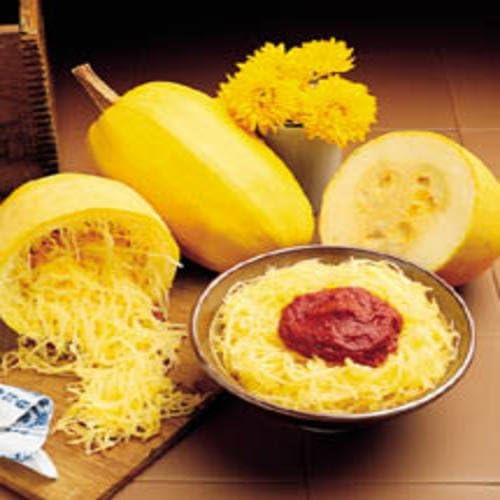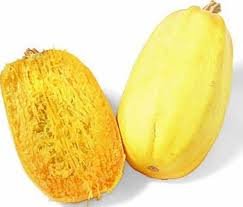Table of Contents
How Many Carbs in Spaghetti Squash? What You Need to Know!
Spaghetti squash is a popular choice for those looking for a delicious, low-carb alternative to pasta. If you’re counting carbs, you might be wondering how many are actually in this veggie. One cup of cooked spaghetti squash contains just 10 grams of carbs, making it a great option for a low-carb diet.

Not only is it low in carbs, but spaghetti squash is also packed with fiber and vitamins, offering a range of health benefits. You can easily incorporate it into various recipes, whether you’re making a hearty dish or a light meal.
With the right preparation, spaghetti squash can become a staple in your healthy eating plan, giving you the satisfaction of pasta without the guilt of high carb counts.
Key Takeaways
- Spaghetti squash offers a low-carb option for pasta lovers.
- It is rich in fiber and beneficial nutrients.
- You can use it in various recipes for healthy meals.
Nutritional Profile
Spaghetti squash is not just a fun pasta alternative; it has a unique nutritional profile that makes it a smart choice for many diets. Let’s break down the important elements you should know about its macronutrients, vitamins and minerals, and dietary benefits.
Macronutrients
When it comes to macronutrients, spaghetti squash offers a refreshing choice. In one cup of cooked spaghetti squash, you get about 42 calories. Most of these calories come from carbohydrates, with roughly 10 grams per serving. What’s interesting is that about 7.8 grams of those are net carbs, making it a standout option for low-carb diets.
The fat content is quite low, usually around 0.4 grams, which is nice if you’re watching your fat intake. The protein amounts to about 1 gram per cup, which isn’t a lot but can complement protein-rich foods nicely. This balance of macronutrients is what makes spaghetti squash a popular choice for those on diets like Keto or Atkins.
Vitamins and Minerals
Spaghetti squash is a good source of several vitamins and minerals. Each serving contains vitamins such as Vitamin C, which supports your immune system, and Vitamin A, important for vision health. You’ll also find minerals like potassium, which helps regulate fluid balance and muscle contractions.
In terms of other nutrients, this squash offers small amounts of calcium, magnesium, and iron. These minerals support bone health and carry oxygen in your blood. Spaghetti squash also has Vitamin K, which is great for blood clotting. Overall, the mix of vitamins and minerals makes it a nutritious addition to your meals.
Dietary Benefits
Including spaghetti squash in your diet can offer many benefits. First, it’s high in dietary fiber, with about 2 grams per cup. Fiber is essential for healthy digestion and can help you feel full longer.
This squash is also low in calories, making it a great option if you’re trying to maintain or lose weight. The antioxidants found in spaghetti squash may also contribute to reducing inflammation and fighting oxidative stress. Plus, its low carbohydrate content makes it an excellent alternative to traditional pasta, especially for those focusing on low-carb or gluten-free diets. Enjoying spaghetti squash can lead to a balanced and satisfying meal.
Health and Dietary Benefits
Spaghetti squash is not just a delicious alternative to pasta; it also offers several health and dietary benefits. This vegetable can support weight management and caters to various dietary needs. Let’s break down what makes it a great choice for many.
Weight Management
If you’re trying to manage your weight, spaghetti squash is a good option. With only about 31 calories per 100 grams, it’s a low-calorie food that can help you feel full without adding many calories to your meals. Its high fiber content promotes a feeling of fullness, making it easier to control your portions.
This squash is also low in sugars, which keeps the calorie count down. If you’re following a low-carb diet, spaghetti squash has about 6.91 grams of carbs per 100 grams, making it a suitable choice. This allows you to enjoy a satisfying meal while still keeping your carb intake low.
Special Diets Compatibility
Spaghetti squash fits well into several diets, making it versatile for various eating habits. It’s perfect for a gluten-free diet, offering a pasta-like texture without the gluten. If you’re into the ketogenic diet, its low-carb count and high fiber make it a suitable option for your meals.
Meanwhile, its glycemic index is low, which means it won’t cause sharp spikes in your blood sugar levels. This can be especially beneficial for those managing diabetes or looking for stable energy levels throughout the day.
Nutrient Density
Beyond being low in calories, spaghetti squash is also a nutrient-dense food. It packs vitamins like beta carotene and vitamin C, essential for your overall health. These nutrients support your immune system and promote healthy skin.
Spaghetti squash is free from cholesterol and contains no saturated fats. You get a good dose of essential minerals without the extra calories. This makes it not just a filling food but also a valuable addition to a healthy diet. Plus, it’s low in allergens, allowing many people to enjoy it without worry.
Cooking and Recipes
Cooking spaghetti squash is simple and offers a great low-carb alternative to traditional pasta. You can enjoy it baked, sautéed, or even as a unique addition to your recipes. Let’s dive into preparation techniques, creative ways to use it in meals, and tips for storing and reheating.
Preparing Spaghetti Squash
To prepare spaghetti squash, start by preheating your oven to 350°F. Slice the squash in half lengthwise, being careful with the knife. Scoop out the seeds using a spoon. You can drizzle a little olive oil and sprinkle salt on the insides for flavor. Place the halves cut-side down on a baking sheet and bake for about 45 to 50 minutes until tender. Once done, let it cool slightly before using a fork to scrape out the spaghetti-like strands. This makes for a fantastic substitute for regular pasta.
Creative Recipe Ideas
Spaghetti squash can replace noodles in many dishes. You can use it in a classic spaghetti marinara or as a base for baked casserole recipes. Try mixing cooked spaghetti squash with sautéed vegetables and a light garlic sauce for an easy stir-fry.
For something special, consider a savory gratin using layers of cooked squash, cheese, and herbs. This dish is not only tasty but also visually appealing when baked until golden. To make it more hearty, add proteins like chicken or shrimp. The options are endless!
Storing and Reheating
If you’ve cooked more spaghetti squash than you can eat, don’t worry! You can freeze cooked spaghetti squash for later use. Just allow it to cool completely, then place the strands in airtight containers. It can last in the freezer for up to three months.
When you’re ready to eat, thaw the squash in the fridge overnight. To reheat, either microwave it for a few minutes or bake it at 350°F until warm. This makes meal prep super easy!
Miscellaneous Facts
Spaghetti squash is a type of winter squash belonging to the species Cucurbita pepo. It’s a tasty, low-calorie vegetable perfect for those looking to cut carbs.
Carbohydrate Content: One cup of cooked spaghetti squash contains about 10 grams of carbohydrates. This makes it a great option if you’re following a low-carb diet.
When it comes to nutrition, spaghetti squash is not just low in calories; it also offers some vitamins. It’s a source of several B vitamins, including vitamin B1, B5, and B12. These are essential for energy production and overall health.
This squash also delivers phosphorus, which is good for bone health. Eating nutrient-rich foods like spaghetti squash can support your weight loss goals, making it a great addition to your meals.
There are different varieties of spaghetti squash, each with slightly different flavors and textures. You might find yellow, white, or even green options at the store.
So, if you’re looking for a filling, healthy alternative to pasta, spaghetti squash is worth a try! You can roast or boil it, then enjoy it with your favorite sauces or toppings.
Frequently Asked Questions
If you’re curious about spaghetti squash and its carbohydrate content, you’ve come to the right place. Here are some common questions that many people have about this unique veggie.
How many carbs in a cup of spaghetti squash?
A cup of cooked spaghetti squash has about 7 grams of total carbohydrates. This makes it a great low-carb alternative for meals.
Can you compare the carbs in spaghetti squash and pasta?
Spaghetti squash has significantly fewer carbs than traditional pasta. Regular pasta can contain around 40 grams of carbs per cup, while spaghetti squash offers a much lighter option.
How many carbs are there in 2 cups of cooked spaghetti squash?
When you have 2 cups of cooked spaghetti squash, you’re looking at around 14 grams of total carbohydrates. This keeps it within a low-carb diet.
What’s the calorie count in half a spaghetti squash?
Half a spaghetti squash has about 30 calories. It’s a light option that allows you to enjoy larger portions without worrying about calorie overload.
Is spaghetti squash a low-carb friendly food?
Yes, spaghetti squash is considered low-carb friendly. With just 7 grams of carbs in a cup, it fits well into low-carb and ketogenic diets.
What are the net carbs in one cup of spaghetti squash?
The net carbs in one cup of spaghetti squash are about 5 grams. This is calculated by subtracting the fiber content from the total carbs, making it a smart choice for low-carb meal plans.

